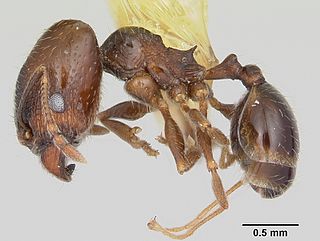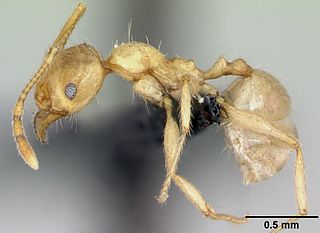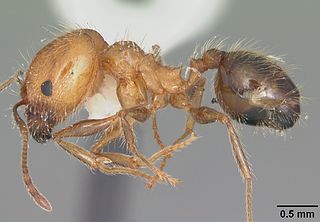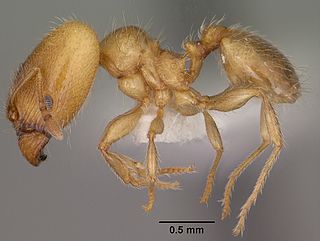Pheidole acutidens is a species of ant in the genus Pheidole. It is endemic to Argentina.

Pheidole elecebra is a species of ant in the genus Pheidole. It is endemic to the United States.
Pheidole parasitica is a species of ant in the genus Pheidole. It is endemic to India.
Pheidole bula is a species of ant in the genus Pheidole. It was discovered in Fiji, and described by E. M. Sarnat in 2008.
Pheidole elongicephala is a species of ant in the genus Pheidole. It was discovered and described by Eguchi, K. in 2008.
Pheidole laevithorax is a species of ant in the genus Pheidole. It was discovered and described by Eguchi, K. in 2008.
Pheidole pegasus is a species of ant in the genus Pheidole. It was discovered and described by Sarnat, E. M. in 2008.
Pheidole rugithorax is a species of ant in the genus Pheidole. It was discovered and described by Eguchi, K. in 2008.
Pheidole vieti is a species of ant in the genus Pheidole. It was discovered and described by Eguchi, K. in 2008.

Pheidole megacephala is a species of ant in the family Formicidae. It is commonly known as the big-headed ant in the USA and the coastal brown ant in Australia. It is a very successful invasive species and is considered a danger to native ants in Australia and other places. It has been nominated as one of the hundred "World's worst" invaders.
Pheidole psilogaster is a species of ant in the genus Pheidole. It is distributed across Mexico, Costa Rica, and Nicaragua.

Pheidole antipodum is a species of ant in the genus Pheidole. It is known only from Australia, where the ants nest in drier regions in soil or under rocks. Little is known about their biology, but they are thought to be specialist predators of termites.

Acanthomyrmex humilis is a species of ant that belongs to the genus Acanthomyrmex. It was described by Eguchi, Bui and Yamane in 2008, and is abundant in Vietnam.

Pheidole pallidula is a species of ant in the genus Pheidole. It is widespread around the Mediterranean.

Pheidole dentata is a species of ant in the genus Pheidole. It is distributed in North America, from the Mid-Atlantic states and southeastern United States to Mexico.

Pheidole bicarinata is a species of ant in the genus Pheidole. It is distributed across United States, from Nebraska, Colorado, Texas, Utah and Nevada, east to New Jersey and Florida.

Pheidole clavata is a species of ant in the genus Pheidole. Pheidole clavata inhabits Eastern and Northern Africa. This species of Pheidole, like many others, are dimorphic, which means that a colony may contain one or several queens. Each colony is made up of two castes: the "minor" workers, and the "major" workers, or "soldiers". The majors have large heads that they use as both weapons and tools to cut open large prey for the colony. The latter generally have enormous heads and mandibles in comparison to their usually fairly modest body size.









